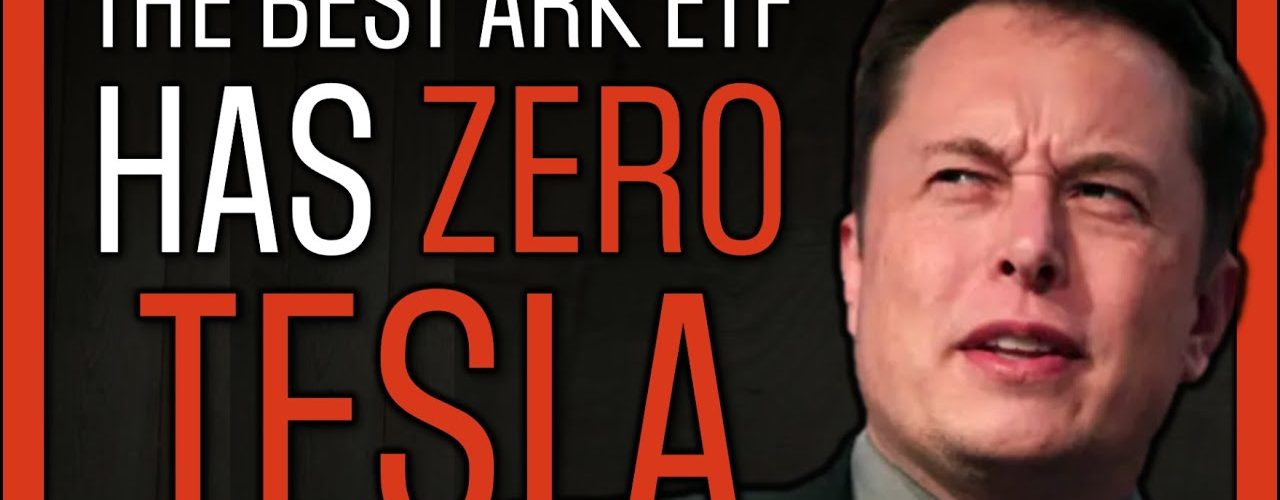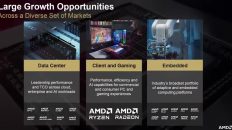Mentioned in Video:
- Big Ideas 2019: Technological Breakthroughs Investors Shouldn't Miss: https://ark-invest.com/articles/analyst-research/big-ideas-2019/
- Genomics Innovation: Healthcare in the Genomic Age: https://ark-invest.com/white-papers/genomics-innovation-white-paper/
- CRISPR Genome-Editing: Market Opportunity and Key Players: https://ark-invest.com/white-papers/crispr-white-paper/
- Genome-Editing: The Value of CRISPR's Intellectual Property: https://ark-invest.com/white-papers/crispr-ip-white-paper/
- Disruptive Innovation: Why Now?: https://ark-invest.com/white-papers/innovation-why-now-white-paper/
- ARK Innovation ETFs: Q3 2020 and Annual Report: https://ark-funds.com/quarterly-webinar/ark-innovation-etfs-q3-2020
- Support the channel and get extra member-only benefits by joining us on Patreon: https://www.patreon.com/tickersymbolyou
#ARKG is #ARK Invest's best-performing ETF even though it doesn't have any #Tesla (#TSLA) in it, yet Tesla is one of their best-performing positions. How can that be? In this video, I explain why #ARKInvest is betting big on #CRISPR (#CRSP), advanced gene-editing techniques, and the genomic revolution. Then, I discuss parts of their decision process for which actual stocks make it into their thematic ARKG fund and compare its performance to their other actively managed ETFs (#ARKK, ARKW, ARKQ, and ARKF). ARKK, ARKQ, and ARKW all have Tesla as their largest holding, making up almost 10% of each. Finally, I explain why this is great news for Tesla bulls who choose to manage their TSLA position but still want to leverage ARK Invest's financial products without overlapping risks (since ARKG does not contain Tesla)!
I am not a financial advisor or affiliated with ARK Invest in any way.
Thanks for watching!
Video Transcript:
[00:00:00.180]
Hey there, Alex here. Welcome back to Ticker Symbol: You, the channel that invests in you. In this episode, we're going to cover everything you need to know about ARKG, ARK Invest's top performing ETF and one that also doesn't contain Tesla in it at all. It took me a long time to research and put together this video so I'd appreciate the early thumbs up and everything I talk about will have links in the description below. Let's dive right in. So this video on ARKG is going to have three parts.
[00:00:28.770]
In part one, I'll do my best to explain the genomic revolution. In part two, we'll talk about how ARK builds and manages their winning portfolios. And in part three, I'll show you that ARKG is the best ARK ETF, even though it contains no Tesla. It's worth remembering that ARK Invest are thematic investors and their five investment themes are DNA sequencing, energy storage, advanced robotics, artificial intelligence and blockchain technology. And on the right you can see ARK's clusters of major innovation platforms and all the disruptive technologies that are resulting from these major innovations.
[00:01:05.250]
So why invest in ARKG? ARKG is a thematic portfolio that covers ARK's idea about the genomic revolution. The genomic revolution themed ETF aims to provide exposure to DNA sequencing technology, gene editing, CRISPR, therapeutics, agricultural biology and molecular diagnostics. These innovations help restructure health care, agriculture, pharmaceuticals and general quality of life. And it's important to remember that all of ARK's investments cut across sectors and geography. And that's what you're seeing here. Health care, agriculture, pharmaceuticals,
[00:01:41.520]
these are all very different economic sectors. But CRISPR and gene editing techniques like it are cutting across them all. So before we go any deeper into ARKG, I'd like to quickly bring up Wright's law. Wright's law is fundamental to ARK's investment thesis across all five of their portfolios and how they build them. Wright's law provides a reliable framework for forecasting cost declines, and all of ARK's ETFs are about understanding cost declines as a way to measure the explosion of innovation in a specific area.
[00:02:12.780]
Wright's law says that for every cumulative doubling of units produced, costs will fall by a constant percentage. Let's go through an example. So let's say it takes a thousand dollars to make the first thousand of something. And let's say the constant percentage that costs will fall by for every doubling is 10 percent. So when we make the next thousand or double for the first time, that should only cost us nine hundred dollars. Then when we make the next two thousand, which doubles from here, it should cost eight hundred and ten dollars or ten percent less than the last two thousand.
[00:02:44.880]
As we keep doubling, our costs keep declining by 10 percent. So as you can see, as we move from the first batch of 1000 to the one hundred and twenty eight thousand, our costs have roughly been cut in half. This is what Wright's law is saying. The more mass production and the more mainstream adoption an innovative technology has, the cheaper it is to create and the cheaper it is to create, the more people can afford it. So Wright's law is really about this cycle of adoption, leading to cheaper prices and cheaper prices leading to more adoption.
[00:03:21.540]
In one of my earlier videos, I talked about how our best will keep making history because they understand it better than anyone else. One of the things they understand better than anyone else is the laws that govern how innovation gets adopted over time. All innovations, no matter how big, have three parts to their lifecycle. In the first part, the technology starts as a proof of concept, and the first parts to prove that concept, for example, in electricity's case, are incredibly expensive, both in time and money to produce.
[00:03:52.080]
As more people and companies get invested, the costs of that production slowly start to decline. That's because people get better at producing something and money is invested in technology to produce it faster. Eventually, institutional knowledge on how to produce that key piece of technology, you know, for example, copper wire or electrical circuits or whatever we're talking about hits some critical point in the curve where it's much easier to produce, which makes it much cheaper to make. Once the technology becomes easy or cheap enough to make, you can pass those cost savings off to the people who have to buy into them.
[00:04:27.780]
This middle plot shows you the adoption curve of electricity across different manufacturing subsectors. As you can see, in the 1890s, electricity was almost not adopted by anyone at all. But in the 30 years after that, by 1920, there have been critical adoption rates of electricity across every major sector. And definitely by 1950 and 60, every sector was using electricity more often than not for means of production. These are things like producing automobiles or building houses or
[00:05:00.030]
powering modern appliances. Think about all of the day to day things you use that require electricity and of course, in part three, new technologies can now stand on top of electricity. For example, innovations in transportation, advanced robotics, electrification and energy storage, communications, and media all rely on electricity to work, and they can each have their own cost curve declines, cross-sector ramifications and spawned new innovations on top of those. If you're interested in learning more about the history of innovation and how ARK uses that history to make its future investments,
[00:05:38.010]
I encourage you to check out my video on why ARK Invest will keep making history. OK, so now let's get back to ARKG. ARK Invest has spotted these declining cost curves in genome editing techniques, and that's the fundamental cost curve that they think is going to decline enough to the point where genome editing techniques will be widely available in every market sector and industry that we use today, just like electricity was over a hundred years ago. So what you're looking at is a table of three genome editing techniques, starting with ZFN, followed by TALEN, and the modern day one called CRISPR.
[00:06:15.480]
And let's take a look at the cost curve decline. The first human cell modification for ZFN occurred in 2003. It took twenty two days to complete and roughly fifty five hundred dollars. In 2009, only six years later, it took 10 days instead of 22 to complete the same task and the cost dropped by over 10x to three hundred and sixty dollars. In 2012, that time got cut in half again to five days and the cost to do that same task dropped by another 10 x down to thirty dollars.
[00:06:48.180]
This is the same pattern that we identified in electricity in that CRISPR is providing for us in the genome editing technique space today. So in this table, it's not that easy to see how each one of these techniques individually impacted this cost curve. ZFN's, TALEN's and CRISPR all played a critical role in lowering the cost of genome editing. So this is the cost decline for TALEN's. As you can see, in 2012, it cost roughly 5000 dollars. And by 2016 it was at that three hundred and sixty dollars mark.
[00:07:21.600]
And even for having to do customized procedures, that cost dropped from ten thousand dollars to roughly two thousand dollars in the same five year span. This is a dramatic cost decline associated with institutions and researchers investing more and more technology, knowledge and infrastructure into the TALEN's techniques. So how does CRISPR fare against TALEN's? Well, there's three main categories of gene modification. Gene knockin and knockout, gene silencing and up regulating and down regulating the expression of genes. So let's compare the costs of these gene modification tasks between these two techniques.
[00:07:57.720]
TALEN's is in orange and CRISPR is in green. This dotted line represents the degree of cost difference between the two techniques. So for example, this triangle here is at around three, which means that CRISPR is about three times cheaper at knocking in and knocking out genes than TALEN's. It's about six and a half times cheaper at gene silencing and it's about four times cheaper at up regulating and down regulating gene expression. So because it costs so much less to sequence a human genome using CRISPR, you can sequence a lot more genomes.
[00:08:31.530]
So the plot you're seeing here shows just that. In 2004, we sequenced two human genomes. In 2007, we increased a third. In 2010, we sequenced a total of eight human genomes and by 2013 we sequenced 10000. When did CRISPR come out again? Oh yeah, 2012. So CRISPR is responsible for this big jump in the number of genomes sequenced. And from there you can see that the number of genomes sequenced is exponentially rising every three years.
[00:09:03.510]
Ten thousand to four hundred and twenty two thousand four hundred and twenty two thousand to ten million. Ten million to one hundred and seventy million. And because we're hitting many cumulative doublings, the costs are declining accordingly. In 2004, it cost roughly a hundred million dollars to sequence a given genome. And today you can get your own DNA, genetic testing and analysis done through services like Twenty Three And Me from the order of a hundred dollars. OK, so the modern gene editing technique is now CRISPR.
[00:09:34.890]
CRISPR is responsible for this annual sequencing volume, sharply rising and reaching two point six million genomes in 2019. And the estimate by 2024 is many more cumulative doublings to one hundred and five million genome sequenced. Remember, this rapid increase in number of genomes sequenced is going to drastically reduce the cost it takes to sequence anyone's genome. And as these costs continue to decline, more and more market sectors will find ways to use this technology to their advantage over timel. Regardless of sector,
[00:10:09.800]
CRISPR also improves every step of the drug development process all the way from foundational research to the actual development of drugs. I really can't overemphasize how important and revolutionary the CRISPR gene editing technique is. On October 7th of this year, the developers of this technique won the Nobel Prize in chemistry. CRISPR is often thought of as the scissors of gene editing: its foundational technique that allows lots and lots of future innovations to sit on top of it. Using this technique, researchers can change the DNA of animals, plants, and microorganisms with extremely high precision.
[00:10:48.290]
This technology has impacts on the life sciences, cancer therapies, agriculture, pharmaceuticals. The list goes on and on. If you're interested in more news pieces like this as they relate to ARK Invest's Biggest Holdings, I encourage you to check out my weekly Market Monday series. In that series, we look at broad economic topics week by week. Then we dive into ARK Invest's specific news like the innovations of one of their top holdings winning a Nobel Prize. And then we look at their weekly buys, sells and trades in that context.
[00:11:20.160]
So we've talked a lot about the cost declines associated with the CRISPR gene editing technique. Let's take a look at all of the different sectors that it's currently affecting. Here are just some of the accomplishments that CRISPR has enabled. It's removed HIV from the three living organisms; it's reversed Huntington's disease in mice. It's encoded and played back a video of a galloping a horse in E. coli bacteria cells. It's edited genetic disease out of human embryonic cells. And of course, probably their biggest innovation to date was genetically modifying you to smash both the like and subscribe button. Nailed it.
[00:11:58.640]
But in all seriousness, as you can see, CRISPR has enabled accomplishments in many different sectors. So far, we've talked about the cost curve declines associated with gene editing, thanks to CRISPR, some of the different sectors that CRISPR is enabling new innovations in. So now let's talk about some of the new innovations that are being stood up on top of CRISPR. One such area is the improvement to agricultural productivity. As you know, the world's population is constantly growing and that's what's being shown in blue.
[00:12:28.670]
Eventually, the number of people that CRISPR based agriculture can feed will outpace the growing population. So in the middle of 2023 or early 2024 we'll be able to produce more crops than we need to feed the entire worldh thanks to CRISPR. This agricultural innovation is an example of just one innovation that's standing up on top of CRISPR. So in addition to medicine, agriculture is another big industry and sector that CRISPR is disrupting. Here's a quick list of some other innovations in the agriculture sector
[00:13:04.220]
thanks to CRISPR. CRISPR allows farmers to raise tuberculosis resistant cattle. It allows them to raise pigs with lower fat content. It allows higher yields of crops that are pesticide free and still weather and bug resistant. In fish, it reduces the gestation period by up to half. It allows aqua farmers to sterilize farm fish to protect local wildlife and, of course, increase disease resistance in aquaculture to avoid things like food poisoning. Now that the costs of gene editing have lowered substantially thanks to CRISPR, many different companies are using it for different agricultural innovations.
[00:13:41.000]
Speaking of companies, the next step in the process is for ARK Invest to decide how to build a portfolio around this revolutionary technique. So what you're seeing here is a map from one of their genomic editing white papers. It focuses on the institutional and foundational patent holders of different gene editing techniques related to CRISPR. It looks at the companies that use these techniques and have relationships with these research institutions, and then it tracks other licenses that these companies may have.
[00:14:10.160]
So, for example, Massachusetts General Hospital works in the space of human therapeutics and one of their surrogates is Editas medicine. Editas is one of the stocks in the ARKG portfolio. And on the right here, I'm just showing you the full map more so you can see the process that they go through to decide which companies are of interest to them for this portfolio. So here's a quick breakdown of the ARKG ETF. On the left, you can see traditional market sectors and on the right you can see innovation platforms.
[00:14:39.710]
So according to a traditional market sector breakdown, this ETF holds ninety seven percent health care, two point five percent information technology and zero point four percent in what I'm assuming is cash. I'm showing you this because one of ARK Invest's claims is that if you're investing in innovation, technology, that's very forward looking. It doesn't make sense to use traditional market sectors to break it down, and that's what you're seeing here, this breakdown explains almost nothing about the fund. Instead, ARK Invest also breaks down their composition by the different innovations that it contains.
[00:15:14.480]
For example, the ARKG fund contains twenty three point five percent exposure to molecular diagnostics. It contains thirteen point seven percent exposure to gene therapy, 12 percent to bioinformatics, eight percent to specifically next generation oncology, so on and so forth. When we talk about ARK Invest's portfolios, I strongly encourage you to think about the composition in terms of the innovation platforms it contains, not just the sectors that it crosses. I think that this table on the right is much more informative than the table on the left.
[00:15:50.240]
The reason I want to bring this up is because of how ARK Invest might look at and actively manage risks inside this portfolio. Very briefly, one reason to break your portfolio down by sector is to understand how the stocks within your portfolio move in relation to each other. But as you can see, when all of your portfolio contains only one sector, it's very hard to make any meaningful decisions about the risk of how that portfolio might move in the broader market.
[00:16:17.480]
So another way that Ark investor chooses to break down their portfolios is by innovation platform. For example, as we saw for ARKG, it contains molecular diagnostics, gene therapy and so on. Don't worry about the numbers here. The important part is by breaking things down by innovation platform instead of by market sector, they can get a lot more information about how their stocks are correlated or how the stocks in the same portfolio are moving in relation to each other, even if they're in the same market sector.
[00:16:48.230]
So that's all of the context I think we need to start really looking at the ARKG portfolio as it exists today. Here are its top ten holdings as of November 10th 2020. One thing you can do is look at all of their holdings as a bar chart. So what you're seeing here is the entire ARKG Fund from November 6th 2020, the last time I pulled the data. Their biggest holding in this fund is Invitae. Their second biggest holding is CRISPR down and down the list.
[00:17:15.080]
They have a total of forty five holdings. Forty six if you include cash. The top 50 percent of this fund is represented by their top nine holdings and their bottom 50 percent of the fund is represented by the other thirty six. One reason I like to look at things in terms of bar charts is to understand ARK Invest's level of conviction in each stock relative to every other stock. For example, I would argue ARK Invest has more conviction in Invitae and CRISPR than they do in Regeneron.
[00:17:45.110]
Remember, ARK Invest is not a stock picker. They are thinking about all of these holdings in relation to each other to bring you the best genomic revolution themed ETF. Here's a plot tracking roughly the last one quarter of data for their assets under management in ARKG. And as you can see, on August 7th, the fund contained about one point seven billion dollars worth of assets. And as of November 6th, it contains about three point two billion dollars worth of assets.
[00:18:12.890]
And finally, let me prove to you that ARKG is, in fact, ARK Invest's best performing ETF, even though it contains no Tesla. Here's a graph of the three year performance of all of ARK's ETFs. ARKG is the blue line. ARKK is the gray one. ARKW is the purple line, ARKF is the green line, and ARKQ is the orange line. And what you're looking at here is the last three years of percentage growth of their five funds starting in December of 2017. ARKG has grown a total of one hundred and seventy five percent, followed by ARKK, which has grown just over one hundred and fifty percent then ARKW, which has grown just below one hundred and fifty percent,
[00:18:56.180]
then ARKF, which has roughly doubled and ARKQ, which has still enjoyed over seventy five percent growth. You can of course do the same thing for a two year timeline. You can see that ARKG has grown over one hundred and fifty percent in the last two years and none of the ETFs holding Tesla have matched that growth. ARKK, ARKQ and ARKW, all of which hold Tesla as their number one positions come close but almost never beat out
[00:19:23.480]
ARKG. Here's that same plot, but for the last one year of performance. You can see that ARKG grew by almost one hundred and twenty percent. And of course we can look at their year today performance, which should be very similar to the one year performance because it's almost the end of the year. So looking at the growth of all five of ARK's ETFs as of January 1st, you can see that ARKG has grown the most this year, almost no matter when you look at it.
[00:19:48.620]
And it's the only portfolio that has more than doubled in value this year. So if you're watching this video, chances are you've heard of ARK Invest because of their incredibly bullish stance on Tesla, but. I just showed you that their best performing portfolio has no Tesla in it. How do we reconcile these two facts? So as a quick bonus, I just want to show you ARKG's performance relative to Tesla. As you can see, Tesla had an insane year, growing almost 500 percent.
[00:20:14.970]
And there should be no doubt in your mind that it would outperform ARK Invest's best ETF. Tesla is one company and ARKG is made up of almost 50 different holdings and actively managed ETF will never be able to outperform a stock that reaches parabolic growth. ARK Invest is in business to identify these parabolic growth opportunities and stick them in their portfolio to their benefit. If you're very bullish on Tesla, ou should feel very good about investing some of your money in ARK
[00:20:43.530]
Invest, specifically ARKG, and manage your own Tesla position, knowing that those two things have very different risks and both have very high reward potential. When Tesla goes up, you can trim your position and put it in ARKG and when ARKG goes up, you can trim some of that position and put it in Tesla, remembering that they shouldn't move up and down together very often because ARKG doesn't contain Tesla. If you've made it to the end, you're awesome. This is Ticker Symbol: You. My name is Alex, reminding you that the best investment you can make is in you.
If you want to comment on this, please do so on the YouTube Video Here














